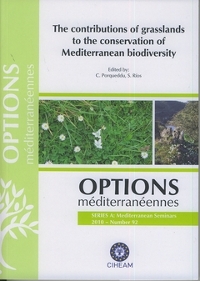| Article précédent | p. 257-260 | Article suivant |
Floristic diversity in semi-natural mountain grasslands included in the Natural Habitat Types of Community Interest
The aim of this work is to evaluate the current situation of the flora and forage production in Pyrenean hay meadows, included in the Natural Habitat Types of Community Interest (NHTCI). 104 phytosociological relevés have been recorded at 4 Huesca Pyrenean valleys, located between 900 and 1700 m a.s.l. Species appearance (percentage of biological forms and Ellenberg values) and structural variables (agronomical families, height grass and production) were measured. Also, specific richness, Shannon and Evenness indices were calculated. A total of 183 species from 34 families were founded. Presence/absence data were analysed with TWINSPAN. As a result, nine grassland groups were identified. Four alliances, Arrhenatherion elatioris, Triseto-Polygonion bistortae, Bromion erecti and Cynosurion cristati, were recognized. The three firsts are included in the NHTCI. In addition, environmental variables were compared with ANOVA test. The results show significant differences between the groups obtained by TWINSPAN for most of the variables. These sustainably managed grasslands have acceptable average productions (ca. 4300 kg DM/ha/year) and keep remarkable species richness values (33 species/plot) and Shannon diversity index (H' = 2.55).
L'objectif de cette étude est d'évaluer la composition floristique et la production des prairies de fauche pyrénéennes se trouvant dans les Habitats Naturels d'Intérêt Communautaire. Durant l'été 2008, 145 relevés floristiques ont été réalisés dans 4 vallées des Pyrénées de Huesca situées entre 900 et 1700 mètres. Nous avons enregistré chacune des variables physionomiques (pourcentages des formes biologiques et index de Ellenberg) et structurelles (pourcentages de groupes agronomiques, hauteur de l'herbe et production), la richesse des espèces a également été calculée ainsi que les indices de Shannon et d'Evenness. Nous avons identifié un total de 183 espèces appartenant à 34 familles. À partir des données de présence/absence des espèces, l'analyse TWINSPAN a été appliquée déterminant 9 groupes de prairies différents. Nous avons reconnu 4 alliances existantes (Arrhenatherion elatioris, Triseto-Polygonion bistortae, Bromion erecti et Cynosurion cristati), les trois premières étant d'intérêt communautaire. D'autre part, nous avons comparé, avec l'analyse de variance, les variables d'environnement. Les résultats montrent des différences significatives entre les groupes obtenus par TWINSPAN pour la plupart des variables. En général, les prairies de fauche des Pyrénées sont utilisées de façon durable, ce qui démontre le maintien de la production fourragère (4300 kg MS/ha/année), la préservation de valeurs importantes pour la richesse des espèces (33 espèces/plot) et la diversité de Shannon (H' = 2,55).
- [ Afficher ]
- [ Télécharger ]
- [ Exporter la citation ]
Vous pouvez télécharger la citation au format :
- [ Imprimer ]
-
Mots-clés
BIODIVERSITE, COMPOSITION BOTANIQUE, ESPAGNE, HERBAGE, REGION D'ALTITUDECiter cet article
Chocarro C., Juarez A., Barrantes O., Reiné R. Floristic diversity in semi-natural mountain grasslands included in the Natural Habitat Types of Community Interest. In : Porqueddu C. (ed.), Ríos S. (ed.). The contributions of grasslands to the conservation of Mediterranean biodiversity. Zaragoza : CIHEAM / CIBIO / FAO / SEEP, 2010. p. 257-260. (Options Méditerranéennes : Série A. Séminaires Méditerranéens; n. 92). 13. Meeting of the Sub-Network on Mediterranean Forage Resources of the FAO-CIHEAM International Network for the Research and Development of Pasture and Forage Crops, 2010/04/07-10, Alicante (Spain). http://om.ciheam.org/om/pdf/a92/00801252.pdf



